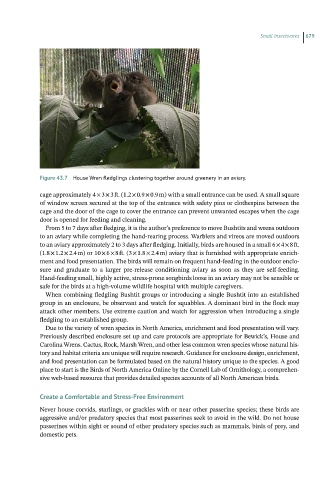Page 678 - Hand rearing birds second
P. 678
Small Insectivores 679
Figure 43.7 House Wren fledglings clustering together around greenery in an aviary.
cage approximately 4 × 3 × 3 ft. (1.2 × 0.9 × 0.9 m) with a small entrance can be used. A small square
of window screen secured at the top of the entrance with safety pins or clothespins between the
cage and the door of the cage to cover the entrance can prevent unwanted escapes when the cage
door is opened for feeding and cleaning.
From 5 to 7 days after fledging, it is the author’s preference to move Bushtits and wrens outdoors
to an aviary while completing the hand‐rearing process. Warblers and vireos are moved outdoors
to an aviary approximately 2 to 3 days after fledging. Initially, birds are housed in a small 6 × 4 × 8 ft.
(1.8 × 1.2 × 2.4 m) or 10 × 6 × 8 ft. (3 × 1.8 × 2.4 m) aviary that is furnished with appropriate enrich-
ment and food presentation. The birds will remain on frequent hand‐feeding in the outdoor enclo-
sure and graduate to a larger pre‐release conditioning aviary as soon as they are self‐feeding.
Hand‐feeding small, highly active, stress‐prone songbirds loose in an aviary may not be sensible or
safe for the birds at a high‐volume wildlife hospital with multiple caregivers.
When combining fledgling Bushtit groups or introducing a single Bushtit into an established
group in an enclosure, be observant and watch for squabbles. A dominant bird in the flock may
attack other members. Use extreme caution and watch for aggression when introducing a single
fledgling to an established group.
Due to the variety of wren species in North America, enrichment and food presentation will vary.
Previously described enclosure set up and care protocols are appropriate for Bewick’s, House and
Carolina Wrens. Cactus, Rock, Marsh Wren, and other less common wren species whose natural his-
tory and habitat criteria are unique will require research. Guidance for enclosure design, enrichment,
and food presentation can be formulated based on the natural history unique to the species. A good
place to start is the Birds of North America Online by the Cornell Lab of Ornithology, a comprehen-
sive web‐based resource that provides detailed species accounts of all North American birds.
Createa Comfortableand Stress-FreeEnvironment
Never house corvids, starlings, or grackles with or near other passerine species; these birds are
aggressive and/or predatory species that most passerines seek to avoid in the wild. Do not house
passerines within sight or sound of other predatory species such as mammals, birds of prey, and
domestic pets.

